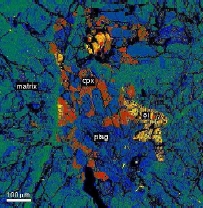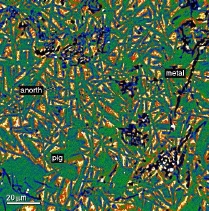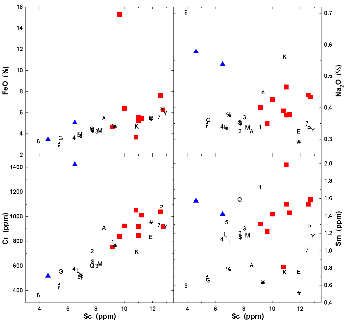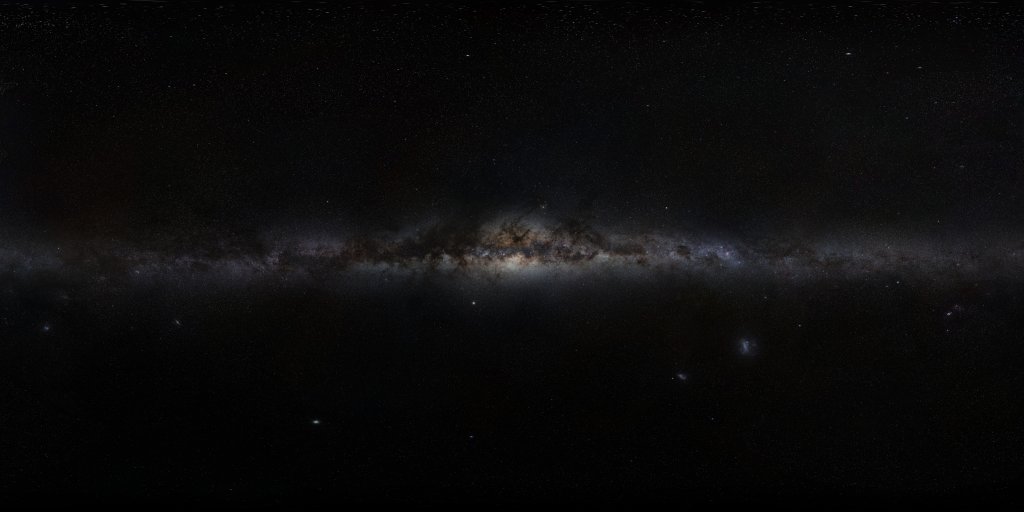|
Petrology: Some clasts are themselves breccias,
implying that multiple impact and mixing events have
affected a leucogabbroic to gabbroic anorthosite protolith.
Most clasts consist of coarse grained (0.5-2.7
mm) calcic plagioclase (An96.1-98.0Or<0.1), pigeonite
(Fs32.0-64.5Wo6.7-13.1, FeO/MnO = 51.1-62.0, some with
fine exsolution lamellae) and olivine (Fa23.9-58.8,
FeO/MnO = 81-100) with accessory kamacite (up to 2
mm), merrillite, Mg-ilmenite, Ti-chromite, baddeleyite,
rare zirconolite, silica polymorph, K-feldspar and troilite.
Some gabbro clasts have shock injection veins
composed mostly of glass containing myriad fine troilite
blebs and engulfed mineral fragments.
Black, vitreous-appearing clasts consist of sporadic,
small angular fragments (apparently surviving relics) of
gabbro and related mineral phases in a very fine
grained, non-vesicular matrix of thin pigeonite laths
(up to 20 µm long x 2 µm wide) and interstitial plagioclase
with tiny kamacite spheres, irregular grains of
schreibersite and rare troilite (see Figure 4).

Figure 4: False-color BSE images of black impact
melt clast. A (above) Relict gabbro fragment in fine
matrix. B (below) Texture of quenched matrix.

Oxygen Isotopes: Replicate analyses of a gabbro
clast by laser fluorination gave δ17O = 2.601, 2.684;
δ18O = 5.014, 5.033; Δ17O = -0.036, +0.037 per mil;
the mean Δ17O value falls within error on the TFL.
|
|
Bulk Composition: INAA of 10 small subsamples
gave preliminary mean abundances of: (in wt. %) FeO
5.30, Na2O 0.43; (in ppm) Sc 10.0, Cr 915, Co 19.6, Ni
240, Hf 1.0, Th 0.44, Ba 290, La 3.11, Ce 8.4, Sm
1.42, Eu 0.89, Tb 0.29, Yb 1.11, Lu 0.156, with considerable
scatter (see Figure 5). The REE pattern has a
moderate positive Eu anomaly. One leucogabbro subsample
containing a grain of apparently igneous metal
has 15.4 wt.% FeO, 6060 ppm Ni, 388 ppm Co, 300
ppb Ir and 102 ppb Au (with Ni/Co like in some irons).
Two aliquots from a single black impact melt clast
have higher Na contents (and one has much higher Cr)
than the gabbroic subsamples; this may reflect a sampling
effect both in the original production of shock
melt and in modal heterogeneity between subsamples.

Figure 5: Compositions of NWA 5000 subsamples in
comparison to other feldspathic lunar meteorites (keyboard
symbols). Red squares = gabbro and matrix subsamples;
blue triangles = black impact melt clast.
Conclusions: Based on our preliminary studies,
NWA 5000 incorporates portions of an ancient feldspathic
leucogabbroic massif in the lunar highlands,
which was brecciated and veined by injected impact
melt, then mixed in further impacts with sparse
amounts of other lithologies, indurated during shallow
burial, and finally ejected into an Earth-crossing orbit.
Reference: [1] Korotev R. L. (2005) Chemie Erde 65,
297-346.
Acknowledgements: We very much appreciate the photographic
and editing skills of Pat McGiffert, Adrian Giesy
and Jim Wittke.
|

